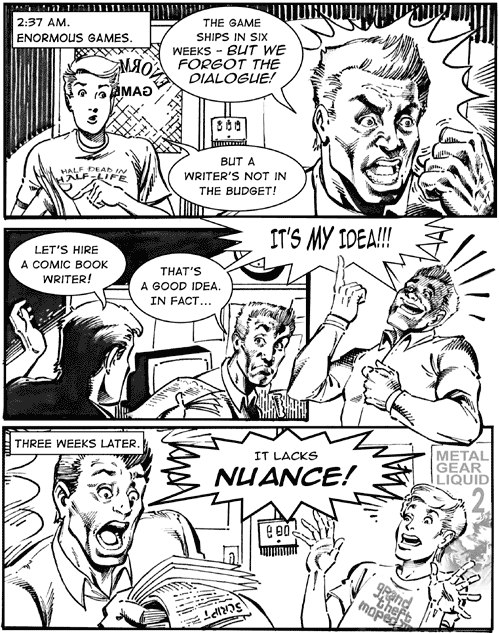Putting It in Focus
| Lest you misunderstand, the warnings in this chapter aren't to convince game companies not to hire a professional writer and pay him or her very well. The goal here is to stop a game company from paying the wrong writer extremely well. Just as extraordinary writers turn movies into gold at the box-office, extraordinary designer/writers can help increase a game's visibility and profits. (See Chapter 1.3, "Why Put Emotion into Games?") To cite some old chestnuts, Grand Theft Auto III and Vice City each use dozens of techniques to keep players emotionally engaged, and their success is legendary.
If, indeed, that's how you feel, before you touch those socks, consider this: My only intention is to save game publishers and developers from throwing away tons of money and ending up feeling (and being) burnt and used. And this is what will happen if they latch onto the idea of hiring famous or talented screenwriters as the magic pill that will instantly give their games some kind of emotional depth and competitive edge.
I love reading certain comics, and make a yearly pilgrimage to that mind-warping orgy of popular aesthetics, Comic-Con.[5] I always come away from the event inspired and even awed by the talent I've met. I understand why some game companies might turn toward comic-book writers. After all, they have a proven ability to convey story and characters with minimal dialogue. You'll even find some images from comic books in this book.
My personal belief, however, is that if a game requires complex and rich characters and stories, the skills and talents needed could very well exceed that of many comic-book writers. (Of course, there are exceptions to this statement.)
If you read Chapter 2.31, "Pre-Rendered and In-Game Cinematics,"[6] you'll see exactly how 35 writing techniques can be layered on top of each other in one short scene. Only a very few comic-book writers have the skills necessary to go back and forth from comics to film or television, and I think that's because the majority of comic-book writers don't have an easy command of all these techniques, not to mention the additional couple hundred that a savvy writer should have at his or her beck and call.
This isn't to say that comic books aren't a remarkably rich medium. The expressive combinations of words and images, and even the imaginative and evocative ways pages are often laid out, make comics a unique and amazing art form.[7] But comic-book writers aren't the perfect "quick fix" for games any more than screenwriters are.
To truly be a strong asset to game design, a screenwriter or comic-book writer must be superb in his/her craft and meet the conditions described next. |
EAN: 2147483647
Pages: 394
